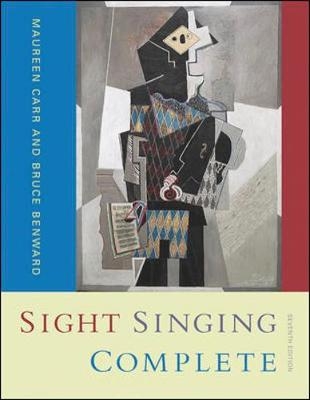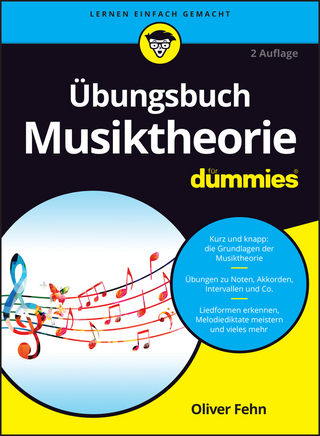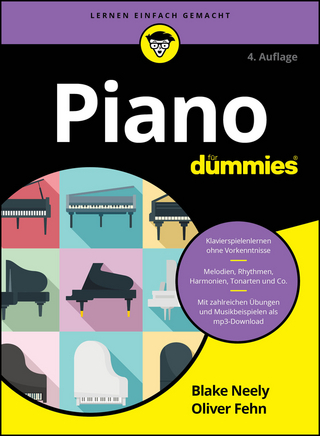
Sight Singing Complete
McGraw-Hill Professional (Verlag)
978-0-07-312706-4 (ISBN)
- Titel ist leider vergriffen;
keine Neuauflage - Artikel merken
Designed for the sight singing component of the Freshman and Sophomore music major curriculum, Sight Singing Complete presents the essential components of this sometimes difficult skill in a practical and effective manner. "Hearing music with one's eyes" has served as the theme of Sight Singing Complete since the first edition. In order to reach this goal, the sequence of instructional material is designed to help students develop the aural skills that will enable them to reverse the compositional process of sound into symbol to one of symbol into sound. The comprehensive and systematic approach employs literature, drawing most of the examples from actual pieces instead of devising contrived melodies. The abundant new exercises in this edition refresh the text, even as the proven exercises continue to educate students.
Maureen A. Carr, professor of music theory, is the recipient of the 2005 Penn State Faculty Scholar Medal for Outstanding Achievement in the Arts and Humanities. Carr received her award for her books, Multiple Masks: Neoclassicism in Stravinsky's Dramatic Works on Greek Subjects (University of Nebraska Press, 2002) and Stravinsky's Histoire du soldat (A-R Editions, 2005), which position her as an authority on Stravinsky's musical sketches and one of the leading scholars on the music of Stravinsky. Her research has been conducted primarily in Switzerland at the Paul Sacher Stiftung in Basel. In addition, she has worked at archives in Winterthur, Lausanne, London and Paris. She has received grants from the Penn State Institute for the Arts and Humanities, the College of Arts and Architecture, the American Association of University Women and Pro Helvetia. She has presented papers at national and international conferences in Belgium, England and Ireland (June, 2005). This summer, she will continue her research in European archives, for a new book addressing the collaboration between Stravinsky and Picasso for Pulcinella. In the Fall semester, she will be in residence at the Penn State Institute for the Arts and Humanities. She will present her research on Pulcinella at the 2005 meeting of the American Musicological Society in Washington, D. C. Carr has a B. A. from Marywood College, an M.F.A. from Rutgers and a Ph.D. from the University of Wisconsin at Madison. She has served on several national and regional committees related to the field of music theory. In 1995, she received the College of Arts and Architecture's Outstanding Teaching Award. In 1998, she was named a Distinguished Alumna by the University at Madison School of Music and in 2004 received a Marywood University Professional Achievement Award. Bruce Benward has been widely regarded as one of the most gifted music theory pedagogues since his textbooks first appeared in the 1960s, and has exerted a wide influence on the teaching of music theory both through his writings and through the generation of teachers that he taught. He recently retired from the University of Wisconsin at Madison.
Unit 1 A. Rhythm—Simple Meter: One-, Two-, and Three-Beat Values B. Diatonic Models and Melodic Fragments for Interval Singing: M2nd and m2nd C. Melodies (Major): M2 and m2 D. Melodies (Major): P5, P4, M3, and m3 within the Tonic Triad and M2 and m2 E. Ensembles—Two Voices: M2 and m2Unit 2 A. Rhythm—Compound Meter: Triple Division of the Beat B. Diatonic Models and Melodic Fragments for Interval Singing: P5, P4, M3, m3, M2, and m2 C. Melodies (Major): P5, P4, M3, and m3 within the Tonic Triad and M2 and m2 D. Melodies (Major): P5, P4, M3, and m3 within the Tonic Triad and M2 and m2 E. Ensembles—Two Voices: P5, P4, M3, and m3 within the Tonic Triad and M2 and m3Unit 3A. Rhythm—Simple Meter: Duple Division of the BeatB. Diatonic Models and Melodic Fragments for Interval Singing: P8, P5, P4, M3, m3, M2, and m2C. Melodies (Major): P5, P4, M3, and m3 within the Tonic Triad and M2 and m2D. Melodies (Minor)E. Ensembles—Two Voices: P5, P4, M3, and m3 within the Tonic Triad and M2 and m2Unit 4A. Rhythm—Simple Meter: Quadruple Subdivision of the BeatB. Diatonic Models and Melodic Fragments for Interval Singing: m10, P8, P5, P4, M3, m3, M2, and m2C. Melodies (Major and Minor): P5, P4, M3, m3, M2, and m2D. Melodies (Major and Minor): P5, P4, M3, m3, M2, and m2E. EnsemblesUnit 5A. Rhythm—Simple Meter: Irregular Division of the Beat (the Triplet)B. Diatonic Models and Melodic Fragments for Interval Singing—New Intervals: M6 and m6C. Melodies (Major and Minor): New Intervals: M6 and m6D. Melodies (Major and Minor): New Intervals: M6 and m6E. EnsemblesUnit 6A. Rhythm—Simple Meter: More Difficult—Quadruple Subdivision of the BeatB. Diatonic Models and Melodic Fragments for Interval Singing—Review: M6 and m6C. Melodies (Major and Minor): M6 and m6D. Melodies (Major and Minor): M6 and m6E. EnsemblesUnit 7A. Rhythm—Review of Simple Meter with Emphasis on Irregular Division of the Beat: The TripletB. Diatonic Models and Melodic Fragments for Interval Singing—New Interval: M7C. Melodies (Major and Minor): New Intervals: M6 and m6D. Melodies (Major and Minor): New Intervals: M6 and m6E. EnsemblesUnit 8A. Rhythm—Review of Simple Meter and Compound MeterB. Diatonic Models and Melodic Fragments for Interval Singing—New Interval: M7C. Melodies (Major and Minor): m7D. Melodies (Major and Minor): m7E. EnsemblesUnit 9A. Rhythm—Compound Meter: Subdivision of the BeatB. Diatonic Models and Melodic Fragments for Interval Singing—New Intervals: A4 and d5C. Melodies (Major and Minor): Chromatic Alterations, Modulating and NonmodulatingD. Melodies (Major and Minor): Chromatic Alterations, Modulating and NonmodulatingE. EnsemblesUnit 10A. Rhythm—Simple Meter: Mixed Meters and Irregular Division of the BeatB. Diatonic and Chromatic Models and Melodic Fragments for Interval Singing—Review: A4 and d5C. Melodies with Chromatic AlterationsD. Melodies with Chromatic Alterations: Modulating E. EnsemblesUnit 11A. Rhythm—Compound Meter and Simple Meter: Irregular Divisions of the Beat (the Quartolet in Compound Meter, and the Triplet in Simple Meter)B. Diatonic and Chromatic Models and Melodic Fragments for Interval Singing—New Intervals: d7 and A2C. Melodies with Unusual Modal CharacteristicsD. Melodies—Chromatic Alterations: Modulating and NonmodulatingE. EnsemblesUnit 12A. Rhythm—Compound Meter and Simple Meter: Subdivision of the Beat into Eight PartsB. Diatonic and Chromatic Models and Melodic Fragments for Interval Study—New Intervals: A6 and d3C. Melodies with Unusual Modal CharacteristicsD. Melodies—Chromatic Alterations: Modulating and NonmodulatingE. EnsemblesUnit 13A. Rhythm—Simple Meter: The SupertripletB. Diatonic and Chromatic Models and Melodic Fragments for Interval Singing—New Interval: d4C. Melodies Related to JazzD. Melodies by Duke EllingtonE. EnsemblesUnit 14A. Rhythm—Simple Meter and Compound Meter: The SubtripletB. Diatonic, Chromatic, Whole-Tone, and Octatonic Models and Melodic Fragments for Interval SingingC. Twentieth-Century Cabaret Songs by Arnold SchoenbergD. Twentieth-Century SongsE. EnsemblesUnit 15A. Rhythm—Changing MetersB. Diatonic, Chromatic, Whole-Tone, and Octatonic Models and Melodic Fragments for Interval StudyC. Twentieth-Century Songs for Careful Study and PreparationD. Vocalises by Arthur Honegger, Bohuslav Martinū, and Olivier MessiaenE. Ensembles of the Twentieth CenturyUnit 16A. Rhythm—Twentieth-Century Excerpt for PercussionB. Twelve-Tone Models and Melodic Fragments for Interval StudyC and D. Twentieth-Century Melodies for Careful Study and PreparationE. Ensembles of the Twentieth Century
| Sprache | englisch |
|---|---|
| Maße | 224 x 272 mm |
| Gewicht | 735 g |
| Themenwelt | Kunst / Musik / Theater ► Musik |
| ISBN-10 | 0-07-312706-X / 007312706X |
| ISBN-13 | 978-0-07-312706-4 / 9780073127064 |
| Zustand | Neuware |
| Haben Sie eine Frage zum Produkt? |
aus dem Bereich


